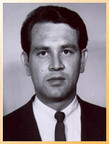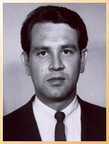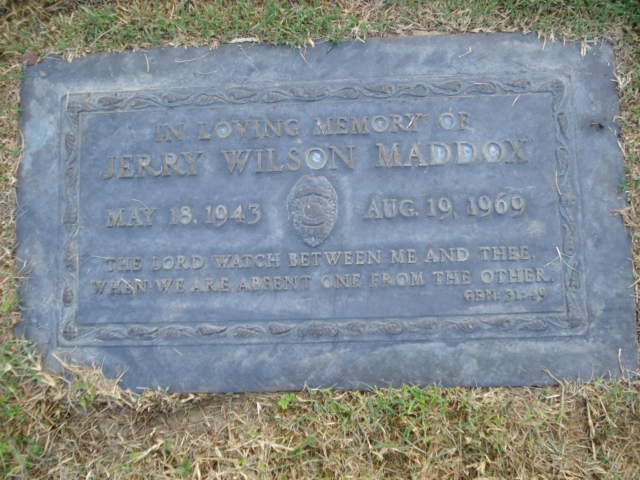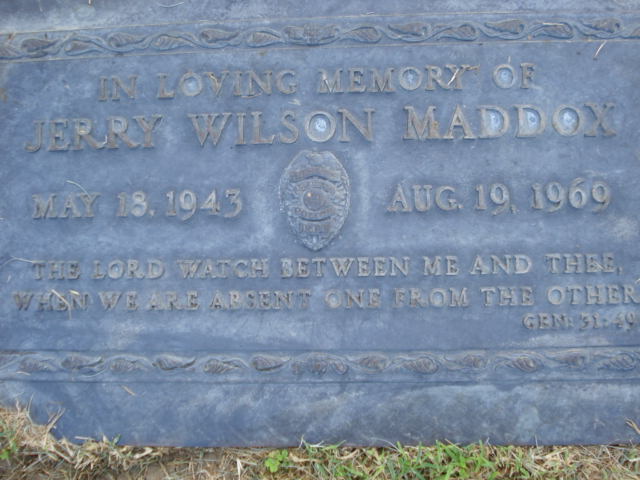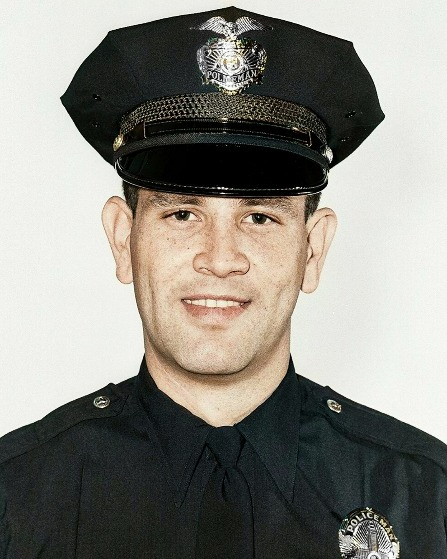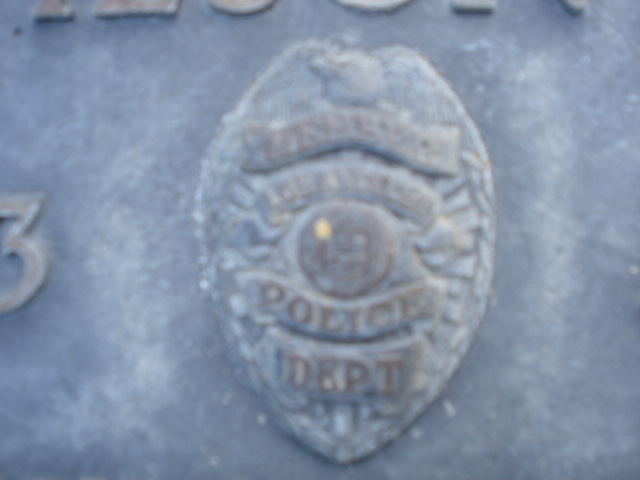Shortly after midnight on August 19, 1969, Hollenbeck Division LAPD Officers Jerry Maddox and Frank Benevidez responded to a call of a disturbance between youth on the 500 block of Gless Street in the Pico Gardens housing project. When they arrived, they saw about 18 to 24 youths. The group quickly scattered as the officers approached and the officers ran after them to detain some for questioning.
Officer Maddox ran down a narrow sidewalk between two apartments and grabbed one of the youths. He would later testify that Maddox told him, “Take it easy, kid. I’m not going to hurt you.” Just then a sixteen-year-old gang member with a long criminal record jumped out from the bushes, grabbed Officer Maddox’s weapon from its holster and shot him once in the back of the neck and then twice in the back as he collapsed to the ground. The suspect then ran out from between the buildings and took two shots at Officer Benevidez before fleeing.
Benevidez radioed for help. Officer David Lewis cornered the suspect on a roof at 518 Boyle Street and ordered him to surrender. Instead he fired at Officer Lewis. Lewis returned the fire and struck the suspect in the groin, leg and shoulder. When he was taken into custody Officer Maddox’s gun was by his side with all six rounds expended.
The legal circus that followed surrounding the suspect rivals anything playing out before us today. There was an immediate move to try the suspect as an adult. On February 3, 1970, a bunch of teenagers marched in front of the Hall of Justice chanting, “16-year-olds should be tried as juveniles… Justica Para Alfredo… Free our brother.” The case ultimately went to the Juvenile Court, twice. In the first case, the suspect confessed to the crime and was convicted, but the California Youth Authority (CYA) refused to accept him stating they did not believe he could be rehabilitated prior to his mandatory release at age 21. This sent the case back to Los Angeles Juvenile Court, but the court now determined he was unfit for trial there because the CYA would not accept him.
On May 26, 1971, the killer entered a plea of not guilty in Superior Court contending that he was being subject to double jeopardy because of his first Juvenile Court conviction. On January 26, 1972, the suspect, now almost 19, was bailed out of jail as the State Supreme Court considered his double jeopardy assertion. This disgusted LAPD Chief Ed Davis who wrote a letter to the chief justice of the California Supreme Court a week later declaring this entire matter to be “Yo-Yo Justice.” The three civil rights attorneys representing the killer then held a press conference demanding Chief Davis be held in contempt of court for sending the letter.
On July 16, 1972, Officer Maddox’s murderer was back in jail on suspicion of his involvement in another murder between rival Hispanic gangs. The next day the State Supreme Court ruled that it was not double jeopardy to retry him in Los Angeles Superior Court for Officer Maddox’s murder and the case could move forward. In May 1973, he was convicted and the following month received a sentence of five-years to life in prison.
Sadly, he did not remain in prison long. In 1975, the United States Supreme Court made a ruling declaring that someone convicted in Juvenile Court could not then be retried as an adult in Superior Court for the same crime. Armed with this new decision, an appeal was made for the murderer’s release. On April 28, 1976, in a 4-3 decision, the California Supreme Court ordered the suspect be released from prison based on the U.S. Supreme Court’s ruling.
Officer Maddox was only 26 when he was murdered. He had been a member of the LAPD just 13 months. In January 1970, the Los Angeles Times published a long article on his widow Carol as she mulled over whether she would take the test to join the LAPD. It appears she chose not to apply.
Sources: Los Angeles Times, John Stanley, LA County Peace Officers Memorial
Shortly after midnight on August 19, 1969, Hollenbeck Division LAPD Officers Jerry Maddox and Frank Benevidez responded to a call of a disturbance between youth on the 500 block of Gless Street in the Pico Gardens housing project. When they arrived, they saw about 18 to 24 youths. The group quickly scattered as the officers approached and the officers ran after them to detain some for questioning.
Officer Maddox ran down a narrow sidewalk between two apartments and grabbed one of the youths. He would later testify that Maddox told him, “Take it easy, kid. I’m not going to hurt you.” Just then a sixteen-year-old gang member with a long criminal record jumped out from the bushes, grabbed Officer Maddox’s weapon from its holster and shot him once in the back of the neck and then twice in the back as he collapsed to the ground. The suspect then ran out from between the buildings and took two shots at Officer Benevidez before fleeing.
Benevidez radioed for help. Officer David Lewis cornered the suspect on a roof at 518 Boyle Street and ordered him to surrender. Instead he fired at Officer Lewis. Lewis returned the fire and struck the suspect in the groin, leg and shoulder. When he was taken into custody Officer Maddox’s gun was by his side with all six rounds expended.
The legal circus that followed surrounding the suspect rivals anything playing out before us today. There was an immediate move to try the suspect as an adult. On February 3, 1970, a bunch of teenagers marched in front of the Hall of Justice chanting, “16-year-olds should be tried as juveniles… Justica Para Alfredo… Free our brother.” The case ultimately went to the Juvenile Court, twice. In the first case, the suspect confessed to the crime and was convicted, but the California Youth Authority (CYA) refused to accept him stating they did not believe he could be rehabilitated prior to his mandatory release at age 21. This sent the case back to Los Angeles Juvenile Court, but the court now determined he was unfit for trial there because the CYA would not accept him.
On May 26, 1971, the killer entered a plea of not guilty in Superior Court contending that he was being subject to double jeopardy because of his first Juvenile Court conviction. On January 26, 1972, the suspect, now almost 19, was bailed out of jail as the State Supreme Court considered his double jeopardy assertion. This disgusted LAPD Chief Ed Davis who wrote a letter to the chief justice of the California Supreme Court a week later declaring this entire matter to be “Yo-Yo Justice.” The three civil rights attorneys representing the killer then held a press conference demanding Chief Davis be held in contempt of court for sending the letter.
On July 16, 1972, Officer Maddox’s murderer was back in jail on suspicion of his involvement in another murder between rival Hispanic gangs. The next day the State Supreme Court ruled that it was not double jeopardy to retry him in Los Angeles Superior Court for Officer Maddox’s murder and the case could move forward. In May 1973, he was convicted and the following month received a sentence of five-years to life in prison.
Sadly, he did not remain in prison long. In 1975, the United States Supreme Court made a ruling declaring that someone convicted in Juvenile Court could not then be retried as an adult in Superior Court for the same crime. Armed with this new decision, an appeal was made for the murderer’s release. On April 28, 1976, in a 4-3 decision, the California Supreme Court ordered the suspect be released from prison based on the U.S. Supreme Court’s ruling.
Officer Maddox was only 26 when he was murdered. He had been a member of the LAPD just 13 months. In January 1970, the Los Angeles Times published a long article on his widow Carol as she mulled over whether she would take the test to join the LAPD. It appears she chose not to apply.
Sources: Los Angeles Times, John Stanley, LA County Peace Officers Memorial
Sponsored by Ancestry
Advertisement
Explore more
Sponsored by Ancestry
Advertisement
